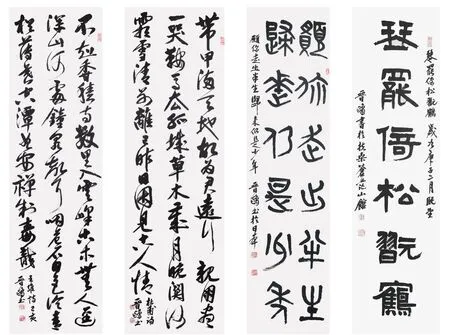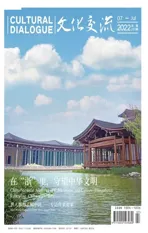晋鸥与中日艺术文化的三种缘
2022-07-28徐子衿
文/ 徐子衿

晋鸥(左三)在日本东京参加由浙江省文化和旅游厅主办的“来诗画浙江,为亚运喝彩”文旅交流展。Jin Ou delivers a speech at an calligraphy exchange event commemorating the 40th anniversary of the friendly relations between Zhejiang province and Shizuoka prefecture.
日语里有个词叫“一期一会”,意思是表演茶道的人会在心里怀着“难得一面,世当珍惜”的心情来诚心礼遇面前每一位品茶客人。其实,最早这个日语词汇前面还有一个佛教禅语的中文译词叫“会者定离”,可以通俗解释为世事无常,聚散总相随。“会者定离,一期一会;勿怀忧也,世相如是。”这两个词连在一起组成的这一句禅语,提醒人们要珍惜生命中每个瞬间的机缘,并为人生中可能仅有的一次相会付出真心。
人们常说,篆刻是最被赋予“一期一会”意义的艺术形式之一,因为在治印过程中,刀与印料之间的碰撞会产生无数细小的崩裂纹理,没有规律可寻,凭的是艺术家的天赋、功底、敏感度、创造力和审美情操,这让篆刻艺术充满了未知的魅力,每一方印章都是独一无二的。
在积极响应并全力协助杭州国家版本馆展开海外版本征集工作的名单里,就有一位旅居日本三十年、一直活跃于中日书法篆刻界而久负盛名的浙江籍艺术家—晋鸥。
晋鸥是西泠印社会员、中国书法家协会会员、日本产经国际书展评委,同时也是日本华人文联主席、全日制本华人印社社长、全日本华人书法家协会名誉主席,他的书法篆刻在日本拥有众多忠实粉丝,在国内深受许多藏家青睐。几十年来,他为中日书法篆刻的文化艺术交流发展作出了杰出贡献。走近晋鸥,发现他至今走过的人生之路充满关于缘分、情义和渊源的故事,能让人不自觉地联想到“一期一会”禅语中蕴藏着的精妙深意—相逢是缘,不负流年不负卿。
这缘,是他和篆刻之缘,和东瀛之缘,和收藏之缘;将这三个缘加在一起来读,便能更加深刻地理解他对推动中日艺术文化交流的殷殷之情和拳拳之心。
与篆刻之缘
1957年,晋鸥出生于浙江桐乡乌镇,从小受其父亲熏陶,酷爱文学和艺术。20岁以前,都是自学,机缘巧合下得以师从钱君匋、刘江、韩天衡、陈舜今等书画篆刻名家。其中,与钱君匋先生相识的缘分来自钱老在桐乡一位学生的介绍,后来他到上海向钱老请教,钱老经常拿出一些名人字画让其观赏,并作细心讲解。赴日之前,晋鸥一直在桐乡君匋艺术院专职研究篆刻和书法。
当初,在学艺的路上总有人说他是“一根筋”。“的确是这样,没有人能阻挡我的创作热情,跟老婆谈恋爱时,她父亲也无奈地说,‘这个人什么都好,就是喜欢练书法,练书法又不能当饭吃’。”晋鸥笑道。钱君匋先生在86岁时回忆起这位学生,仍对其孜孜矻矻的钻研精神和日渐精进的艺术成就记忆犹新:“青年书家晋鸥,兼工各体,篆书整饰雄峻,隶书丰满多姿,行书巧拙互见,草书清丽流畅,小楷师法晋唐大家,倜傥无馆阁味。刻印佳者颇多,入秦出汉,刀韵石味,苦追天然。”
回首往事,晋鸥还曾得到过沙孟海老先生的指点。当时,他先后去杭州拜访沙老很多次,前3次都吃了闭门羹,又去了第4次。那天非常冷,晋鸥搭了别人单位的卡车来到沙老家门前,保姆看他冻得可怜便让他进了屋,并告诉他下周三来,沙老会在家。后来终于和沙老见上了面,沙老鼓励他说,只要持之以恒,一定会功夫不负有心人。
此后,晋鸥的书法、篆刻作品曾在全国大赛获得20多个大奖,并在上海举办个人书画篆刻展,出版个人书画篆刻作品集,成为国内书画篆刻界冉冉升起的一颗新星。
就在那时,又一个机缘悄然而至,并从此改变了晋鸥的人生轨迹。1990年,晋鸥在杭州西泠印社参加篆刻大赛时,日本著名篆刻家、全日本篆刻联盟会长小林斗盦带了一批学生来浙江做艺术交流,其中就有日本篆刻家三圭出版社社长三井雅博。三井雅博在学习中文,也非常喜欢晋鸥的书法篆刻,两人一见如故。三井回国后两人仍一直保持书信往来。三井对晋鸥说:“现在日中文化交流频繁,晋先生若能掌握日语,对中日文化交流一定会有很大帮助。如果你想来日本学习,我可以帮你办理留学手续。”
与东瀛之缘
抱着“走出国门看一看”的想法,在家人和单位的支持下,1992年春,晋鸥来到日本,一切从零开始。从就读语言学校到考上东京学艺大学研究生,求学之路异常艰辛和孤独,为了赚取学费和支付9平方米住房的房租,他不得不同时打两份工。
时来运转发生在1996年,在一位日本朋友的帮助下,晋鸥进入日本著名的三越百货店刻章,虽然只有一周,却成为他的篆刻进入日本艺术界视线的“敲门砖”。当时,一个刻章并不能赚多少钱,但占据了他一天中的大部分时间,最长的一天刻了16个小时。
这过程中还发生了一件事,至今仍深深地影响着他。当时有一位80多岁的日本老太太拄着拐杖,手上挽着布包,找到了晋鸥的篆刻台,拿出10多方印章对他说 :“这是我丈夫年轻时去中国观光时买的,由于时间紧来不及刻,保存至今,现在他已经过世了,但我想委托您帮我刻好这些印章,以了却他的心愿。”老太太拿出一张纸,上面写着五六个名字,除了名字,她还拜托晋鸥在剩余的印章上刻上中国的成语名言。这对晋鸥触动很大,他初次意识到日本民间对于中国传统篆刻艺术和文化是如此的推崇。“日本人对中国文化的热爱令我感动,中国博大精深的文化能在海外如此深入人心,我感到很骄傲,很想做点什么。”晋鸥说。
后来,当从东京学艺大学硕士毕业时,晋鸥的篆刻艺术已经得到了日本各大博物馆、美术馆、百货店画廊的认可。在日本最初的10年里,他刻了2万多方印章,为了不负各种有缘人的不同期待,必须想方设法在方寸天地之间谋篇布局、痛下功夫。
正是因为这些难忘而宝贵的磨练和际遇,晋鸥的篆刻艺术造诣不断攀登上新的高峰并且吐故纳新、自成一格,他借鉴了日本浮世绘、埃及壁画,以及毕加索、梵高绘画中的抽象造型,在创作上进入了一种随心从容的自由境界。如今在日本,由他篆刻的印章成为近百家博物馆、美术馆等各大艺术场所争相销售的宠儿。
2002年,晋鸥在千叶县野田市成立了“晋鸥艺术学院”,教授日本人书法、篆刻和绘画。在日本,几乎所有老师都把书、画、篆刻分为三个门类,很少有人会像晋鸥一样,一个人同时教授三种艺术,并且注重因材施教、教学相长,因而吸引众多书画、篆刻爱好者从日本各地慕名前来学习。
与收藏之缘
1997年秋,中国历史博物馆文物展在京都高岛屋美术馆举办,晋鸥刚好在会场刻印。有一天,美术馆馆长带来一个60多岁的人介绍给他说:“这是以前日本大画家桥本关雪之孙桥本归一先生。”在得知晋鸥来自浙江时,桥本的话匣子一下收不住了:“我爷爷生前一共去了中国一百多次,浙江是我爷爷最爱去的地方,因为那里有西泠印社,在那里我爷爷结识了很多书画篆刻界的朋友,其中交往最深的是钱瘦铁先生。从前钱瘦铁先生还在我家住过好几年呢。”
过了几天,晋鸥应邀去桥本家做客,走进大厅便能看见桥本父亲的6折行书屏风,书学颜真卿。桥本的书房里,有一些中国篆刻家的印章,以钱瘦铁先生的居多,其中还有两方是钱老用樱花木刻的印章。据晋鸥回忆,桥本当时又拿出用黄布包着的两方紫檀盒装砚台,两方砚台上都有吴昌硕铭款,边用手擦砚台边感慨地说:“这是《沈氏研林》中的名砚,以前家里有一百多方,现在只剩下这两方,算是传家宝了。”

1.晋鸥篆刻艺术馆。2.晋鸥在浙江省·静冈县友好城市40周年纪念书法交流展上致辞。3.晋鸥(后排右四)与华人学生们在日本晋鸥艺术馆前合影。1.Jin Ou Seal Carving Art Museum. 2.Jin Ou delivers a speech at an calligraphy exchange event commemorating the 40th anniversary of the friendly relations between Zhejiang province and Shizuoka prefecture. 3.Jin Ou (fourth on the right on the second row) takes a photo with overseas Chinese students in front of the Jin Ou Art Museum in Japan.
后来有一次,桥本和晋鸥相约到杭州拜访钱瘦铁先生的亲戚钱大礼先生,不巧的是钱先生出差在外,又逢周日,西泠印社的骨干和社员们大多在休息。“我本想打电话通知他们,被桥本先生阻止了,说不必惊动大家。至今我还在后悔,当时怎么就没有和大家联系,一起见个面,留下几张有意义的照片呢?”晋鸥感慨道。
没想到的是,那一次的遗憾再也无法改写,某一天,晋鸥收到桥本家族寄来的明信片:“先生已在一个月前谢世,为了不打扰你工作,故至今才通知你,请见谅。”
直到去年年底,他还在自己的专栏中写下关于《沈氏研林》中各方名砚的故事。虽然一想起便有很多不舍,但或许恰恰是与桥本先生结下的这一段艺术缘,为晋鸥的艺术生涯打开了另一扇窗。从最初在友人处单纯学习鉴赏到受人委托、为艺术藏品寻找买家,再到后来经济宽裕后开始自行收购各类藏品;直至今日,除了精于书画篆刻,晋鸥在日本收藏圈也是位名人。
逐渐地,晋鸥意识到艺术品收藏不仅仅是个人的事情,艺术应该是社会共有、穿越时空的宝贵精神遗产。5年前,晋鸥还向桐乡君匋艺术院捐赠了自己收藏的王一亭《松鹤图》,以回报艺术院的培育之恩。曾经,晋鸥的心愿是在家乡设立一座美术馆,让自己收藏的400余件珍贵字画、印章能够回归故里,其中让他颇感自满的藏品有 :吴昌硕作品近20件,王一亭作品50多件,还有王铎、董其昌、文徵明等名人的书法作品,有黄宾虹、张大千、傅抱石等大家的字画等,具有一定的质量和规模。“人生最多能活到一百岁,艺术品却是永恒共有的,所以将来希望自己收藏的艺术品,能有一个好归宿。”这便是一个浙江赤子良善朴素而令人敬佩的愿望。
以书法凝心
现在,在桐乡建造晋鸥艺术馆的期盼即将达成。晋鸥谈到:“我想把这个艺术馆作为浙江与海外文化交流的一个窗口。通过这个平台,可以将日本的优秀文化引进来,把中国的文化、艺术传播出去。作为身在海外的游子,把中华优秀传统文化传播到海外,让世界人民能更好地了解中华文化,是我的责任与使命。”可惜的是,晋鸥艺术馆装修好了,但受困于新冠肺炎疫情,他至今没能回去着手开馆工作;晋鸥篆刻艺术馆已经开馆一年多了,也一直无法亲眼去看看。
即使如此,疫情却仍挡不住他对传播中华优秀传统文化、推动中日艺术文化交流的热忱。去年,在中国驻日本大使馆的支持下,他成功组织并主持了在日华侨庆祝建党百年书画展,吸引了众多日本政要、中日友好人士和日本民众来到现场参观一幅幅写满祝福和热爱的翰墨丹青。此外,他还在东京参加了由浙江省文化和旅游厅主办的“来诗画浙江,为亚运喝彩”文旅交流展活动,并以日本华人文联主席身份致词:“我看到很多日本民众在现场体验书法、篆刻和剪纸,心里自豪又欣慰。杭州是历史文化名城,希望日本能更多地与浙江进行文化、体育方面的交流。”
30年来,晋鸥先后带领日本访问团前往中国近百次,在日本策划“丰子恺故乡赴日漫画展”“西泠印社日本三大展”“浙江青田篆刻艺术展”等大型展览,还参与协办数十个中日书法交流展,为中日两国书法篆刻艺术交流倾尽全力。对他有知遇之恩并成为挚友的三井雅博曾这样谈起晋鸥:“经常听他讲要成为‘中日文化艺术交流的桥梁’,来日这么多年这一信念至今没有改变。”
2004年,晋鸥与几位在日华侨书法家共同筹建“全日本华人书法家协会”。他希望可以通过该协会团结起在日华人书法家,共同进行书法篆刻的艺术创作、研究与交流。同时,通过华侨华人的桥梁作用,促进中国国内书法家、书法团体与日本书法篆刻界进行更多更深入的交流与交往。
当年,书圣王羲之在绍兴兰渚山下以文会友,写下“天下第一行书”—《兰亭序》,唐代四大书法家中有两个都和浙江有关系。“日本民众中有不知道现任首相的,但没有人不知道王羲之。”晋鸥坦言,在海外传承和发扬中国书法艺术,是自己下一个十年要做的最重要的事。他曾做过调查和统计,在近100万在日华侨中,有练习书法习惯的仅有几百人。对此,晋鸥的心情是急切而焦虑的。为了让更多华侨华人学习书法篆刻,他每月在东京中国文化中心开办公益书法教室,指导华侨华人学习书法,书法课不收学生一分钱,完全免费。从几年前开始,他每年都要举办几场大型公益书法讲座。
另一方面,晋鸥认为,艺术文化交流过程中还应该以有容乃大的心态去研究和欣赏日本书法家的闪光点。他希望,将来能收藏百幅日本名家的书法,向国内书法界介绍日本书法的特点,只有知己知彼才能不断进步。“日本的文化源自中国,又有很多自身的创新,中日文化之间有很多共通之处,地域上又是一衣带水的邻邦,这其中确实有很多微妙的缘分,两国在艺术文化交流上需要更加深层次的思考和探索。”晋鸥补充道。

晋鸥书法作品。Calligraphy works by Jin Ou.
Jin Ou’s Destiny with Art and Culture in China and Japan
By Xu Zijīn
In Japanese, there is a word “ichi-go ichi-e” (for this time only), which means that the tea ceremony performer will sincerely treat every guest in front of him/her. This reminds people of cherishing every once-in-a-lifetime moment.
Seal engraving is considered one of the art forms that are fully endowed with the meaning of “ichi-go ichi-e”, because during the carving process, countless tiny crumbling textures will be created by the knife cutting into the carving material, which, with no pattern to follow, fully depends on the artist’s talent, skills,sensitivity, creativity and aesthetics. That gives seal engraving its mysterious charm, because each seal is unique.
There is a famous Zhejiang artist named Jin Ou, who has lived in Japan for 30 years and has long been active in the Chinese and Japanese calligraphy and seal carving circles. He is among those who have responded positively and assisted the China National Archives of Publications and Culture (Hangzhou) in collecting overseas calligraphy editions.
Jin is a member of the Xiling Seal Art Society, a member of the Chinese Calligraphers Association, a member of the Japan Sankei International Calligraphy Exhibition, as well as the president of the Chinese Literary Association in Japan, the president of the Chinese Seal Society in Japan, and the honorary chairman of the Chinese Calligraphers Association in Japan. Over the decades, he has made outstanding contributions to the cultural and artistic exchanges between Chinese and Japanese calligraphy and seal carving. When we get to know him better, we find that his life is full of stories about how he has been bound with seal carving, with Japan and with collection, which reminds us of the subtle meaning hidden in “ichi-go ichi-e”.
Born in 1957 in Wuzhen, Zhejiang’s Tongxiang city, Jin grew up influenced by his father’s love for literature and art, and he was self-taught until the age of 20. Later he was given the opportunities to study under famous calligraphers and seal carvers such as Qian Juntao, Liu Jiang, Han Tianheng and Chen Shunjin.Before he went to Japan, Jin had been studying seal carving and calligraphy at the Tongxiang Juntao Art Institute.

2019年,晋鸥荣获产经新闻社“书法贡献奖”。(资料照片)In 2019, Jin Ou received an award from Sankei Shimbun for his contributions to promoting Chinese calligraphy. File photo.
Jin has also received guidance from Sha Menghai (1900-1992).Back then, he went to Hangzhou to visit Mr. Sha, only to be shut out for the first three times. But he didn’t give up and went for the fourth time. Finally he got to meet Mr. Sha, who encouraged him that as long as he perseveres, his efforts would be rewarded at the end of the day.
Since then, Jin’s calligraphy and seal engraving works have won more than 20 awards in national competitions. He has also held his own calligraphy and seal engraving exhibitions in Shanghai and published his own collections, becoming a rising star in the Chinese calligraphy and seal engraving circle.
Just at that time, another opportunity came and changed Jin’s life ever after. In 1990, when participating in a seal carving competition at the Xiling Seal Art Society in Hangzhou, Jin got acquainted with Mr. Mitsui, president of Sankyu Publishing House. Mitsui was studying Chinese and loved Jin’s calligraphy and seal engraving, so the two of them clicked immediately. They kept in touch even after Mitsui returned to Japan. Mitsui once said to Jin, “Nowadays, Japan and China have frequent cultural exchanges. If you could master Japanese, it must be very helpful for the cultural exchange between our countries. If you want to come and study here, I can help you with the procedures.”
Therefore, supported by his family and institution, Jin went to Japan in the spring of 1992 and started everything from scratch.From language school to graduate school at Tokyo Gakugei University, he worked extremely hard and had to do two part-time jobs in order to pay his tuition and house rent.
Another life-changer happened in 1996. With the help of a Japanese friend, Jin entered the famous Mitsukoshi Department Store in Japan to work as a seal engraver, which, although lasted for only a week, became the “door knocker” for his seal carving to enter the Japanese art world. Later, when he graduated from Tokyo Gakugei University with a master’s degree, Jin’s seal carving art had already been recognized by major Japanese museums, art museums and galleries. During his first decade in Japan, he carved more than 20,000 seals.
It is because of these unforgettable and precious trials and encounters that Jin’s artistic attainments in seal carving have constantly reached new heights and he has become a unique artist.Drawing on Japanese ukiyo-e, Egyptian frescoes, and the abstract shapes in Picasso and Van Gogh’s paintings, he has been creating after his own heart freely and calmly. Today in Japan, his seals are a favorite in nearly 100 museums, galleries and other major art venues.
In 2002, Jin established the Jin Ou Art Academy in Noda,Chiba prefecture to teach Japanese people calligraphy, seal carving and painting. In Japan, almost all teachers categorize calligraphy,painting and seal carving into three disciplines, and few teach all three at the same time like Jin does, who focuses on teaching each student according to their abilities, thus attracting many enthusiasts from all over Japan.
Jin’s relationship with Mr. Hashimoto, grandson of the great Japanese painter Kansetsu Hashimoto (1883-1945), opened up another window for his art career. From simply appreciating art pieces, finding buyers for artworks on commission, to acquiring various collections on his own, Jin is now a celebrity in the Japanese collectors’ circle.
Gradually, Jin has realized that art collection is not only a personal matter, but also a valuable spiritual heritage that transcends time and space and is to be shared by the society. Jin once wished to set up an art museum in his hometown, where his proud collection of more than 400 precious paintings and seals could be returned and stored.

晋鸥书法作品。Calligraphy works by Jin Ou.
“People live a finite life up to a hundred years, but art is an eternal common asset. In the future, I hope my collection could be preserved properly.” This is the simple and admirable wish from a Zhejiang artist.
Now, the expectation of building the Jin Ou Art Museum in Tongxiang is about to be ful filled. “I want to use this art museum as a window for cultural exchange between Zhejiang and the rest of the world. Through this platform, we can introduce the excellent culture of Japan and spread the culture and art of China,” said Jin. Although due to the pandemic he has not been able to return from Japan to see another museum — Jin Ou Seal Art Museum, which has been opened for more than a year, Jin has always been enthusiastic about promoting art and cultural exchanges between China and Japan.
“Japanese culture originated from China and has been greatly innovated based on that origin. There are many things in common between Chinese and Japanese cultures, and we are neighbors geographically, which indeed connects us in some subtle way.Therefore, we need to further think and explore in our art and cultural exchanges,” Jin added.
